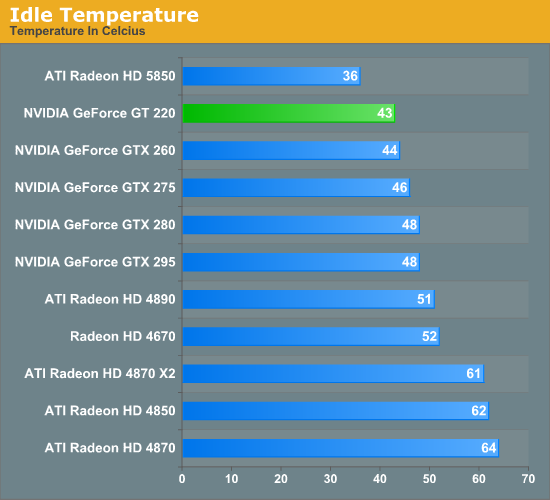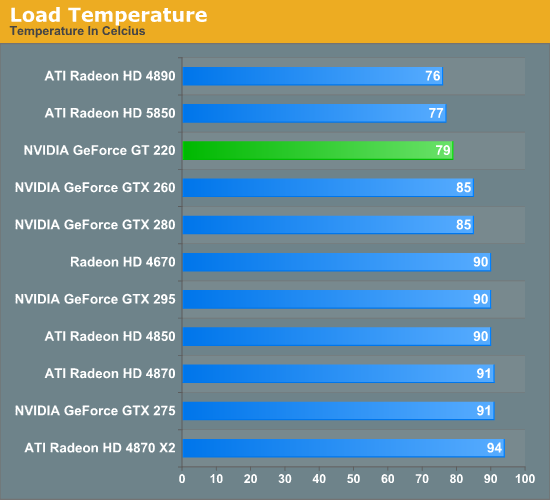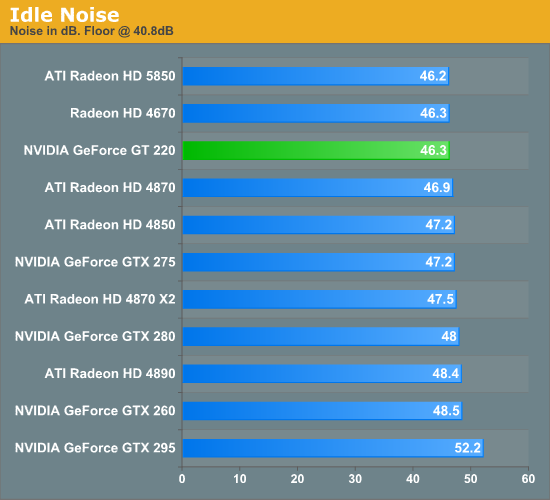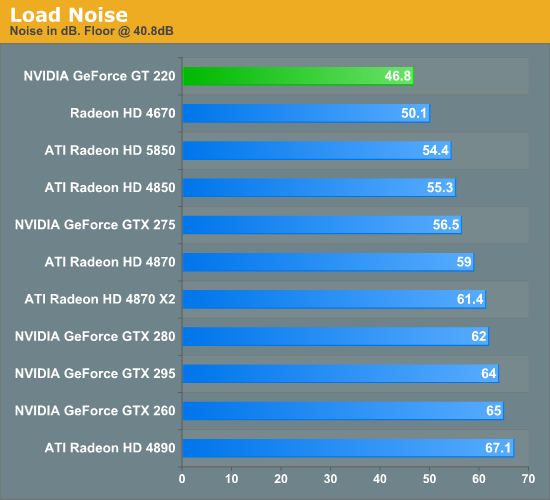NVIDIA’s GeForce GT 220: 40nm and DX10.1 for the Low-End
by Ryan Smith on October 12, 2009 6:00 AM EST- Posted in
- GPUs
Temperature & Noise

At idle, the GT 220 is one cool card. We’re a bit surprised that it couldn’t beat the 5850 here given the tiny 7W idle power usage, but the 5850 has the advantage of getting to vent hot air out the rear of the card.
Meanwhile we see one of the few chinks in the armor of the Radeon HD 4670. It idles a good 9C higher.

Small cards make little heat. Even with the small cooler on the GT 220, it doesn’t pass 79C. This becomes all the more impressive when we look at the noise data. Meanwhile the 4670 hits 90C. It may be the faster card, but it pays for it here.

Here we run up against the practical noise floor of our testing rig. Nothing with a fan can get below 46dB.

With a fixed speed fan, the GT 220 makes the same amount of noise at idle and at load. This means it’s still running into our noise floor under load even though it’s an actively cooled card. It has all the makings of a good HTPC card, if only the price-to-performance ratio was a bit better.
As for the 4670, it comes in at #2 with 50.1dB under load, making it noisier than the GT 220 but quieter than any of our usual suspects on the high-end.










80 Comments
View All Comments
Ryan Smith - Monday, October 12, 2009 - link
I don't have that information at this moment. However this is very much the wrong card if you're going scientific work for performance reasons.apple3feet - Wednesday, October 14, 2009 - link
Well, as a developer, I just need it to work. Other machines here have TESLAs and GTX280s, but a low end cool running card would be very useful for development machines.I believe that the answer to my question is that it's 1.2 (i.e. everything except double precision), so no good for me.
jma - Monday, October 12, 2009 - link
Ryan, if you run 'deviceQuery' from the Cuda SDK, it will tell you all there is to know.Another goodie would be 'bandwidthTest' for those of us who can't figure out the differences between various DDR and GDDR's and what the quoted clocks are supposed to imply ...
vlado08 - Monday, October 12, 2009 - link
My HD 4670 idles in 165MHz core and 249,8MHz memoy clock and GPU temps 36-45 degrees(passively cooled) as reported by GPU-Z 0.3.5 Is there a possibility that your card didn't lower it's clock during idle?vlado08 - Monday, October 12, 2009 - link
My question is to Ryian of course.Ryan Smith - Monday, October 12, 2009 - link
Yes, it was idling correctly.KaarlisK - Monday, October 12, 2009 - link
The HD4670 cards differ.I've bought three:
http://www.asus.com/product.aspx?P_ID=Z9qnCFnOUNDM...">http://www.asus.com/product.aspx?P_ID=Z9qnCFnOUNDM...
http://www.gigabyte.com.tw/Products/VGA/Products_O...">http://www.gigabyte.com.tw/Products/VGA/Products_O...
http://www.asus.com/product.aspx?P_ID=g6LDXHUo0EzV...">http://www.asus.com/product.aspx?P_ID=g6LDXHUo0EzV...
The first one would idle at 0.9v.
The second would idle at 1.1v. When I edited the BIOS for lover idle voltages, I could not get it to be stable.
The third one turned out to have a much cheaper design - not only did it have slower memory, it had no voltage adjustments and idles at 1.25v (but the correct idle frequency).
vlado08 - Monday, October 12, 2009 - link
Are GT 220 capable of DXVA decoding of h.264 at High Profile Level 5.1?And videos wiht more than 5 reference frames. Because ATI HD4670 can only do High Profile (HiP) Level 4.1 Blu-ray compatible.
Also what is the deinterlacing on GT 220 if you have monitor and TV in extended mode? Is it vector adaptive deinterlacing?
These questions are important for this video card because it is obvious that it is not for gamer but for HTPC.
On HD 4670 when you have one monitor then you have vector adaptive deinterlacing but if you have two monitors or monitor and TV and they are in extended mode then you only have "bob" deinterlacing.
I'm not sure if this is driver bug or hardware limitation.
Ryan Smith - Monday, October 12, 2009 - link
I have another GT 220 card due this week or early next. Drop me an email; if you have something I can use to test it, I will gladly try it out. I have yet to encounter anything above 4.1 though; it seems largely academic.MadMan007 - Monday, October 12, 2009 - link
So my inner nerd that just has to know is confused. Are these truly GT200-based or G9x-based? Different sources say different things. In a way the GT200 series was an improvement on G9x anyway but with enough significant low level changes to make it different. The article calls these GT200 *series* but that could be in name only. It's not clear if that means smaller process cut down die GT200-based or added feature G9x-based.Inquiring nerds want to know!